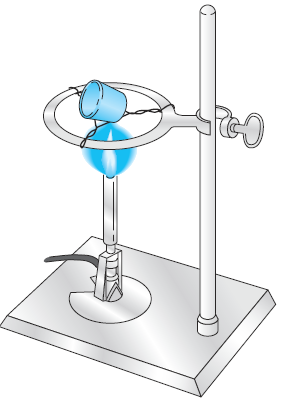


 علم الكيمياء
علم الكيمياء 
 الكيمياء التحليلية
الكيمياء التحليلية 
 الكيمياء الحياتية
الكيمياء الحياتية 
 الكيمياء العضوية
الكيمياء العضوية 
 الكيمياء الفيزيائية
الكيمياء الفيزيائية
 الكيمياء اللاعضوية
الكيمياء اللاعضوية 
 مواضيع اخرى في الكيمياء
مواضيع اخرى في الكيمياء
 الكيمياء الصناعية
الكيمياء الصناعية |
Read More
Date: 25-2-2018
Date: 24-6-2017
Date: 24-4-2017
|
Ashing Filter Papers
If a heat lamp is used, the crucible is placed on a clean, nonreactive surface, such as a wire screen covered with aluminum foil. The lamp is then positioned about 1 cm above the rim of the crucible and turned on. Charring takes place without further attention. The process is considerably accelerated if the paper is moistened with no more than one drop of concentrated ammonium nitrate solution. The residual carbon is eliminated with a burner, as described in the next paragraph. Considerably more attention must be paid if a burner is used to ash a filter paper because the burner produces much higher temperatures than a heat lamp. Thus, mechanical loss of precipitate may occur if moisture is expelled too rapidly in the initial stages of heating or if the paper bursts into flame. Also, partial reduction of some precipitates can occur through reaction with the hot carbon of the charring paper. This reduction is a serious problem if reoxidation following ashing is inconvenient. These difficulties can be minimized by positioning the crucible as illustrated in Figure 1.1. The tilted position allows for the easy access of air.

Figure 1.1 Ignition of a precipitate. Proper crucible position for preliminary charring is shown.
A clean crucible cover should be kept handy to extinguish any flame. Heating should begin with a small flame. The temperature is gradually increased as moisture is evolved and the paper begins to char. The amount of smoke given off indicates the intensity of heating that can be tolerated. Thin wisps are normal. A significant increase in smoke indicates that the paper is about to flash and that heating should be temporarily discontinued. Any flame should be immediately extinguished with a crucible cover. (The cover may become discolored from the condensation of carbonaceous products. These products must ultimately be removed from the cover by ignition to confirm the absence of entrained particles of precipitate.) When no further smoking can be detected, heating is increased to eliminate the residual carbon. Strong heating, as necessary, can then be undertaken. This sequence usually precedes the final ignition of a precipitate in a muffle furnace, where a reducing atmosphere is equally undesirable.



|
|
|
|
5 علامات تحذيرية قد تدل على "مشكل خطير" في الكبد
|
|
|
|
|
|
|
تستخدم لأول مرة... مستشفى الإمام زين العابدين (ع) التابع للعتبة الحسينية يعتمد تقنيات حديثة في تثبيت الكسور المعقدة
|
|
|